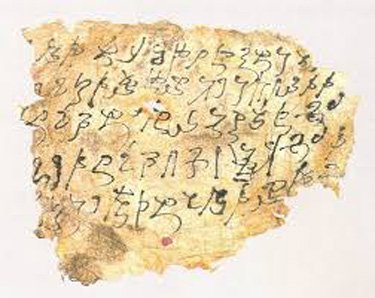Tocharian Deciphered? Apparently Not
Kharosthi Script, Language, Tocharian
According to Language Log, the plot thickens.
[There was] excitement generated a few months ago by the announcement that “Tocharian C,” the native language of Kroraina (Chinese Loulan) had been discovered, hiding, as it were, in certain documents written in the Kharoá¹£á¹hÄ« script (“Tocharian C: its discovery and implications” [4/2/19]). Those documents, with transcription, grammatical sketch, and glossary, were published earlier this year as a part of Klaus T. Schmidt’s Nachlass (Stefan Zimmer, editor, Hampen in Bremen, publisher). However, on the weekend of September 15th and 16th a group of distinguished Tocharianists (led by Georges Pinault and Michaël Peyrot), accompanied by at least one specialist in Central Asian Iranian languages, languages normally written in Kharoá¹£á¹hÄ«, met in Leiden to examine the texts and Schmidt’s transcriptions. The result is disappointing, saddening even. In Peyrot’s words, “not one word is transcribed correctly.” We await a full report of the “Leiden Group” with a more accurate transcription and linguistic commentary (for instance, is this an already known Iranian or Indic language, or do the texts represent more than one language, one of which might be a Tocharian language?). Producing such a report is a tall order and we may not have it for some little time. But, at the very least, Schmidt’s “Tocharian C,” as it stands, has been removed from the plane of real languages and moved to some linguistic parallel universe.
So, what do we have in Schmidt’s “Tocharian C”? I can think of three scenarios, perhaps there are more. First, Schmidt may have subconsciously read into his texts what he wanted to be there. There have certainly been such things happening (the well-known first “transcription” of the Voynich Manuscript by William Romaine Newbold* is such a case). Secondly, and less generously, it may have been an outright fabrication, an attempt at deception. But, what would have been the purpose? Thirdly, and more generously, it might have been a kind of “Tocharian Sindarin”—a created language such as Tolkien played so artistically with, given a certain literary verisimilitude by the reference to old manuscripts where it might be found. If so, it was not meant to deceive, but his family, not having been told of its true nature, passed it on to Zimmer as real. And Zimmer, not being a reader of the Kharoá¹£á¹hÄ« script (precious few Tocharianists are), naturally enough took Schmidt’s transcriptions at face value.




